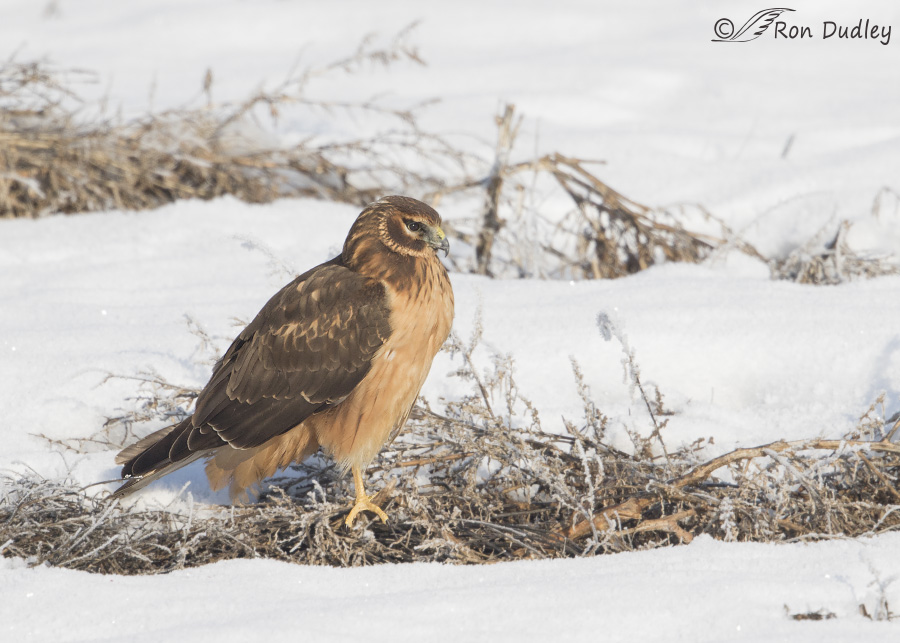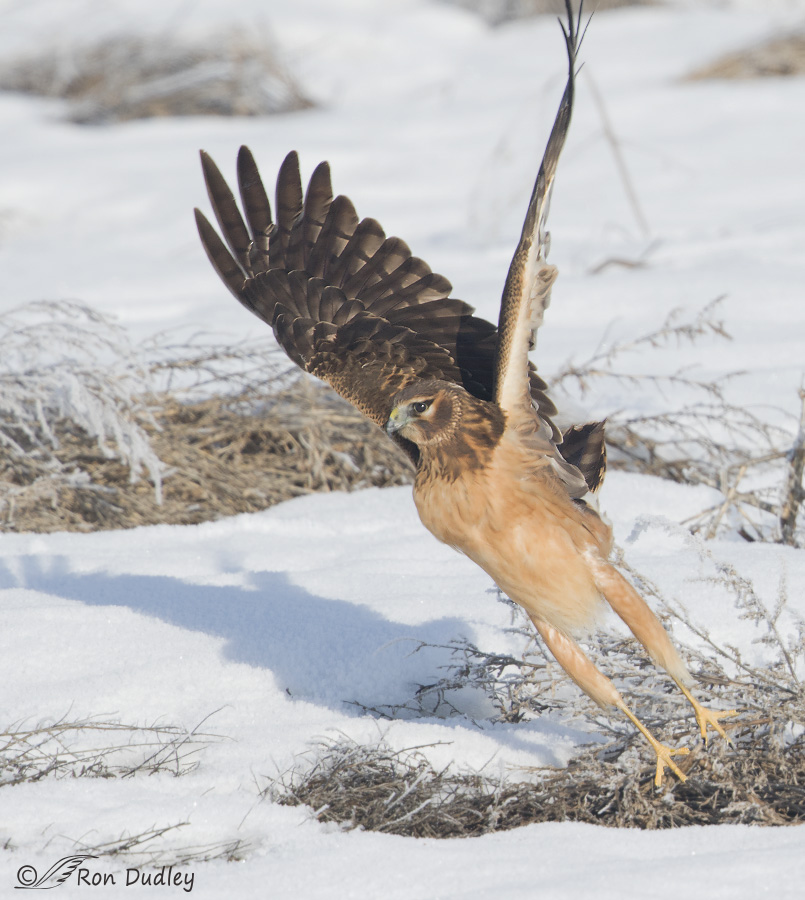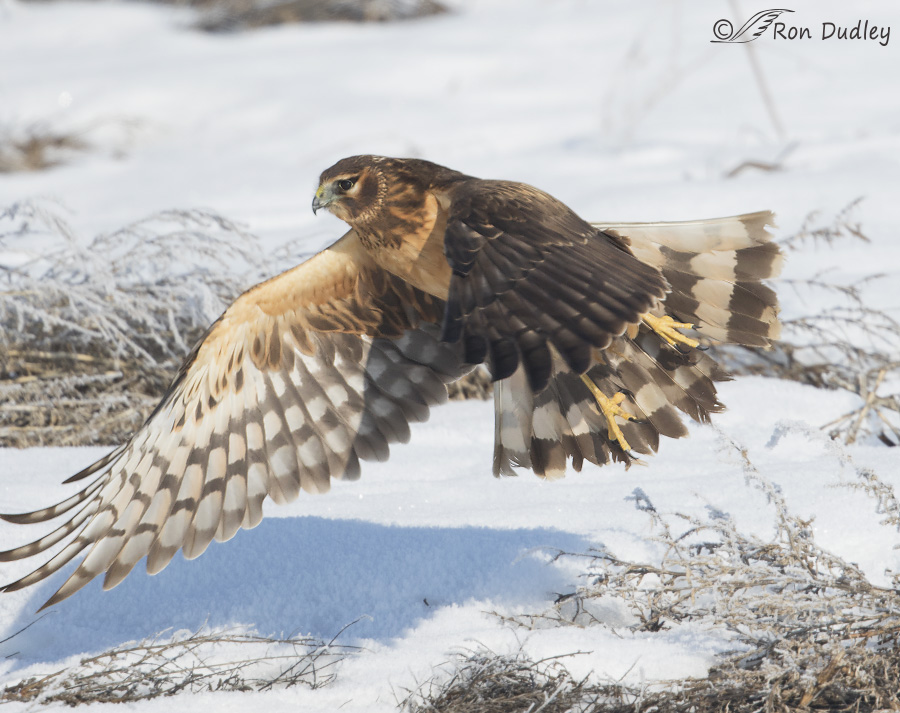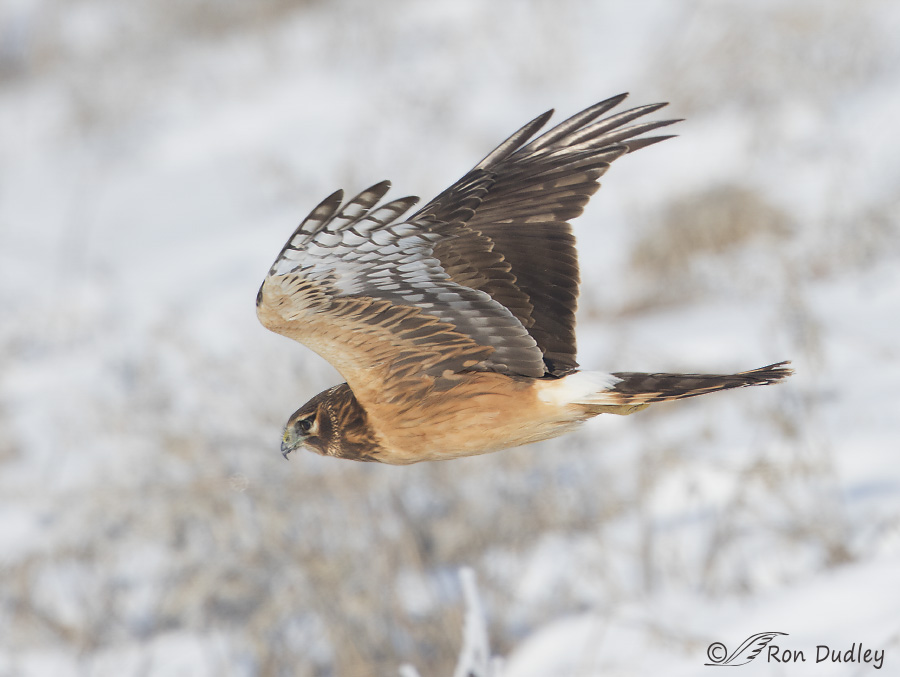One of the biggest challenges of photographing birds at takeoff is avoiding clipped wings. Sometimes I succeed and sometimes I don’t.

1/3200, f/6.3, ISO 500, Canon 7D Mark II, Canon EF 500mm f/4L IS II USM + 1.4 tc, not baited, set up or called in
This Northern Harrier was resting near the road at Farmington Bay WMA yesterday morning. It allowed me a fairly close approach (for a harrier) but it didn’t give me much variety in poses or behavior while it was perched. It made some feeble attempts at throwing a pellet (which it never did) and one time it reacted to another harrier nearby (that I never saw) by putting its other foot down, assuming a more alert pose and calling out to the other bird. But that was about it for interesting behavior.
I spent 14 minutes with my lens trained on the bird and waiting for takeoff. That might sound boring but it’s really pretty tense and lots of things are going through the photographers mind at times like this:
- are my camera settings appropriate for the situation – proper exposure and enough depth of field and shutter speed etc?
- which direction will the bird take off?
- which and how many focus points should be active to give me the best chance to keep the bird in focus during flight?
- how much room should I leave in the frame in which direction(s) to avoid clipping or cutting off those large and fast-moving wings?
With that much time and effort invested all you can do is hope that you’ve made good choices when the bird lifts off because by then it’s just too damned late to make any adjustments.

1/3200, f/6.3, ISO 640, Canon 7D Mark II, Canon EF 500mm f/4L IS II USM + 1.4 tc, not baited, set up or called in
This bird was facing to my right so I planned on that direction for takeoff and left more room in the frame there but in an instant it twisted and took off to my left instead. Either way I’d have likely clipped the wing in this shot because it’s raised to a vertical position. But if I’d left more room to the left in the frame…

1/2500, f/6.3, ISO 640, Canon 7D Mark II, Canon EF 500mm f/4L IS II USM + 1.4 tc, not baited, set up or called in
I wouldn’t have clipped a wing in this shot – potentially my favorite of the series.
The bad news didn’t stop there. After this image I either lost focus or cut off body parts for the next nine shots.

1/2500, f/6.3, ISO 640, Canon 7D Mark II, Canon EF 500mm f/4L IS II USM + 1.4 tc, not baited, set up or called in
By the time my focus point locked on to the bird again it was slightly past me. All the photographer can do in situations like this is make the best decisions you’re capable of and hope for a little luck. But in the end, to quote Mary Chapin Carpenter,…
“Sometimes you’re the windshield. Sometimes you’re the bug”.
Ron


Fantastic photos as usual Ron, just wondering why such high shutter speeds? Wouldnt a slightly slower speed capture motion and also allow for lower ISO resulting in less noise. I shoot with7DM2 also. Thanks Ken Busch
Ken, Regular readers know that I prefer to err on the side of too much SS rather than too little. I shoot in aperture priority so slight changes in background or light as the bird flies change my SS (sometimes reducing it) and I want more than enough just before that happens, if it does. It’s just my style.
I love the golden glow of the birds chest and legs in the second photo. You caught the powerful push off and wing stretch of launching off. It is a very enjoyable photo to look at.
Spectacular Ron!
7
Thanks, Charlotte.
At least in winter there’s a smaller chance of a tiny flying bug trying to make a home in your inner ear canal while you’re trying to get the shot. I always thought John Denver said it well: “Some days are diamond, some days are stone.” Love the Northern Harrier, even with the clipped wings.
I guess I’ve got to look at the bright side, Diane – no bugs during winter. I’ve missed more shots slapping at insects or scratching their bites than I care to count.
Beautiful juvenile.
Thanks, Sallie.
Sometimes you are the fire-hydrant, and other times you are the dog.
I am with Laura here. Except that your picky persona is what keeps you trying to improve. And making some of the rest of us grow more comfortable with feelings of inadequacy. A form of community service.
Love the harrier. And at least you didn’t decapitate it. I have done that before now.
Believe me, I’ve decapitated my share, EC. And worse (I call them “air shots”). I’ll continue to do my community service. Thank you.
Once again, great shots, Ron (back to my standing order here…LOL!). I gotta say that I kinda hate it when you pick your shots apart. Yes, I know that Perfectionist self thing–I’ve got that going on with my words, too, so I get it. But from the perspective of one who’s lucky to get a decent snapshot with MOST of the subject in the frame with or without focus, sometimes I want to thwap you upside the head 😀
And yep, sometimes you’re the statue, sometimes the pigeon. Raptors (and critters in general) have a game they play nearly continuously. There are many variations, but overall, it’s called Watch This–See what I can make the silly two-legged human do! Perhaps the most popular variation is the old, “I can fly. You can’t. Nanner, nanner, nanner!” There’s also the “Watch this! My body can do all sorts of things yours can’t.” Personally, I don’t think there’s any sport in it–our brains are easily thwarted, but evidently they’re easily amused, too. I can frequently hear them giggling under their wings!
I suspect you and I will never change, Laura – you picking apart sentences and me doing the same with my images. We are who we are.
I also think birds are amused when they frustrate us so – they have to be! In their shoes (wings) I would be too…
I have to keep reminding the dogs and birds who live with me that I’m only human–low-hanging fruit!
Ron, these are such great images of this wily bird’s behavior and really show off its striking features! I fully appreciate all the ‘faults’ you outlined, but knowing the tension of ‘the wait’ and having observed their erratic tendencies, I think you did outstanding work. I love the poses, patterns, wing positions and that you included some habitat. BIF are certainly interesting but give me some setting / habitat context and I think it usually improves the story. These absolutely do that in my opinion. Thanks for sharing them with us!
Ah, that time-honored controversy regarding which image type is preferable – birds in habitat or tight shots where the bird fills most of the frame. Many years ago I preferred the latter but now I really like both styles, for different reasons. Thank you, Kim.
Nice series…all beautiful shots, but especially like the second one…showing the athletic spring and fling into the air just before the powerful lift of the the down stroke…fortunately, the clipping is minor….
Yes, that second shot certainly is an athletic pose, Patty. I like it for that reason too.
Ron, I loved this series – not only for this wonderful raptor (even with the clipped wings) but your conversation about what was happening and your thought process is a great nugget of info for this novice photographer who loves the lessons I’m learning from you!! LOL – always the teacher – you just can’t help yourself – it’s part of your DNA!!
I’m glad you’re learning something here on occasion, Jo Ann. That gladdens my teacher’s heart…
Well now I have Mary Chapin Carpenter stuck in my head. Just for that, fella…maybe some day you’ll see a Flying Purple People Eater! Ha!
I hope you’re happy, Arwen! I received your comment email while I was out shooting this morning and for at least the next half hour I had the ear worm you planted. I used to sing that silly song constantly when I was a youngster (even played it on the piano).
You forgot the “One Eyed, One Horned” part, but I certainly didn’t…
YAY! Revenge is sweet. 😀 But I also had the FPPE stuck in my head. 😀
I love the second shot Ron. I do not mind the wing clip. I see the subject as “extension and power” needed for takeoff! You got the leap into the air, the body fully extended and the feeling of power in those wings needed to push for air lift!
Thank you, Nancy. I do still like the clipped shots but not nearly as much as I would if I’d gotten the entire bird in the frame.
They are still great shots Ron, I’m with you though about cutting any tips off. I don’t have as much teach as you do so it probably happens less frequently with me. Harriers are one of my favorites to shoot here in California.
( tied with Peregrines). I shoot with the Canon 7D Mark ll as well and I wondered which case numbers you tend to use and if you vary it with the kinds of birds you shoot, or if you just use one case setting for birds in flight? Thanks.
Judy, I’m STILL playing with those cases with the Mark II so I haven’t settled on anything yet…
Beautiful even if you did get some minor clips! 🙂 “Sometimes you’re the windshield. Sometimes you’re the bug” is VERY appropriate to how these situations go. 🙂 It is a beautiful bird and love the extension on the wings in the first shot.
Judy, that wing extension you refer to is exactly why clipping 3 feather tips in that shot hurt so much because I love it too.
oh, man. that third one hurts… the pain of bird photography!
“the pain of bird photography!”
Truer words were never spoken (or typed) Brian. But the joys of bird photography when you succeed certainly help to compensate…
What a great series regardless!
The colors are rich, marking tack on and with all the mind games that are played while your waiting, I’d say it was a job well done!
“Mind games” is right, Dick. Second thoughts galore!
Something I didn’t mention – if I decide to take my attention off the bird for an instant in order to make a camera adjustment it always seems to choose that nanosecond to take off. Times like that add to my already voluminous repertoire of cuss words…
Yup, my army days resurface to me when that happens!!
Good to be a lone when that happens………..:)
Indeed…20 shots stationary and you’re waiting for lift off. Wait Wait Wait. Then…”hey, how’s the histogram on those stills?” Check it and the bird will see what you’re doing and spoils the shot you’ve been waiting on. They know…somehow…they know.